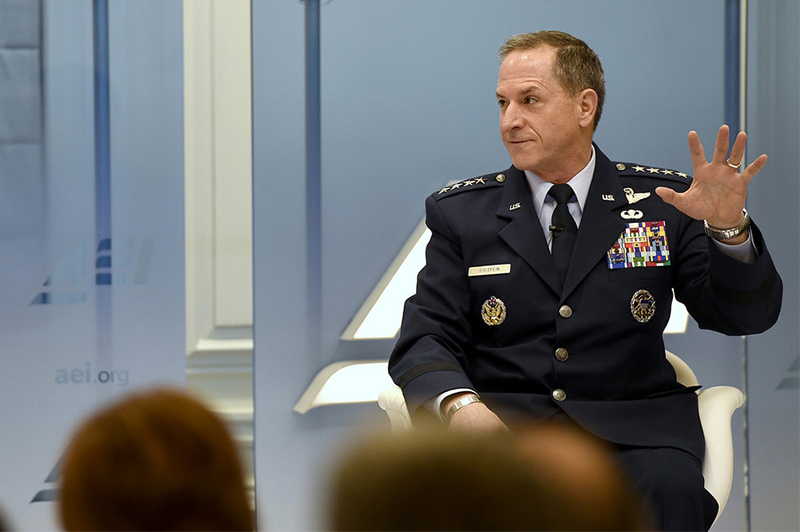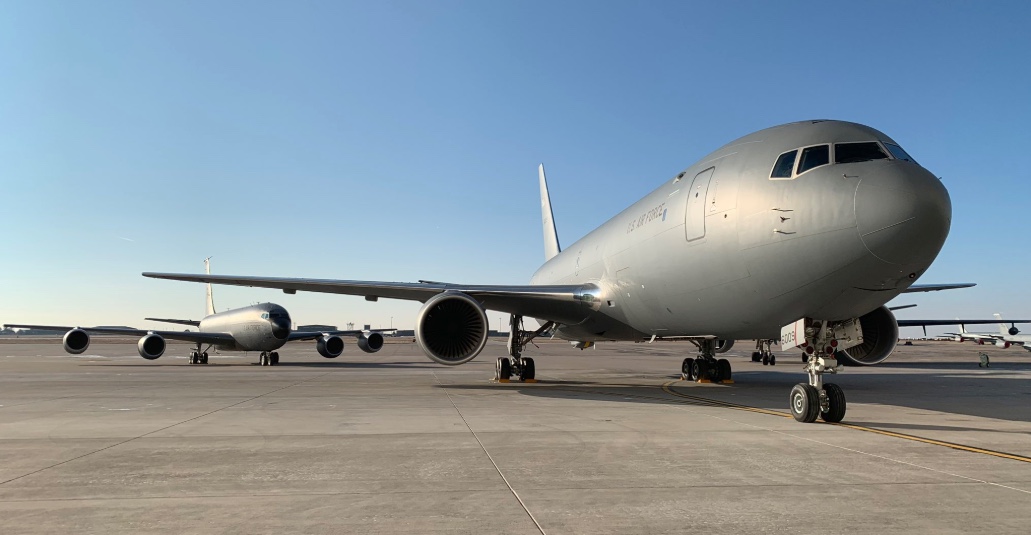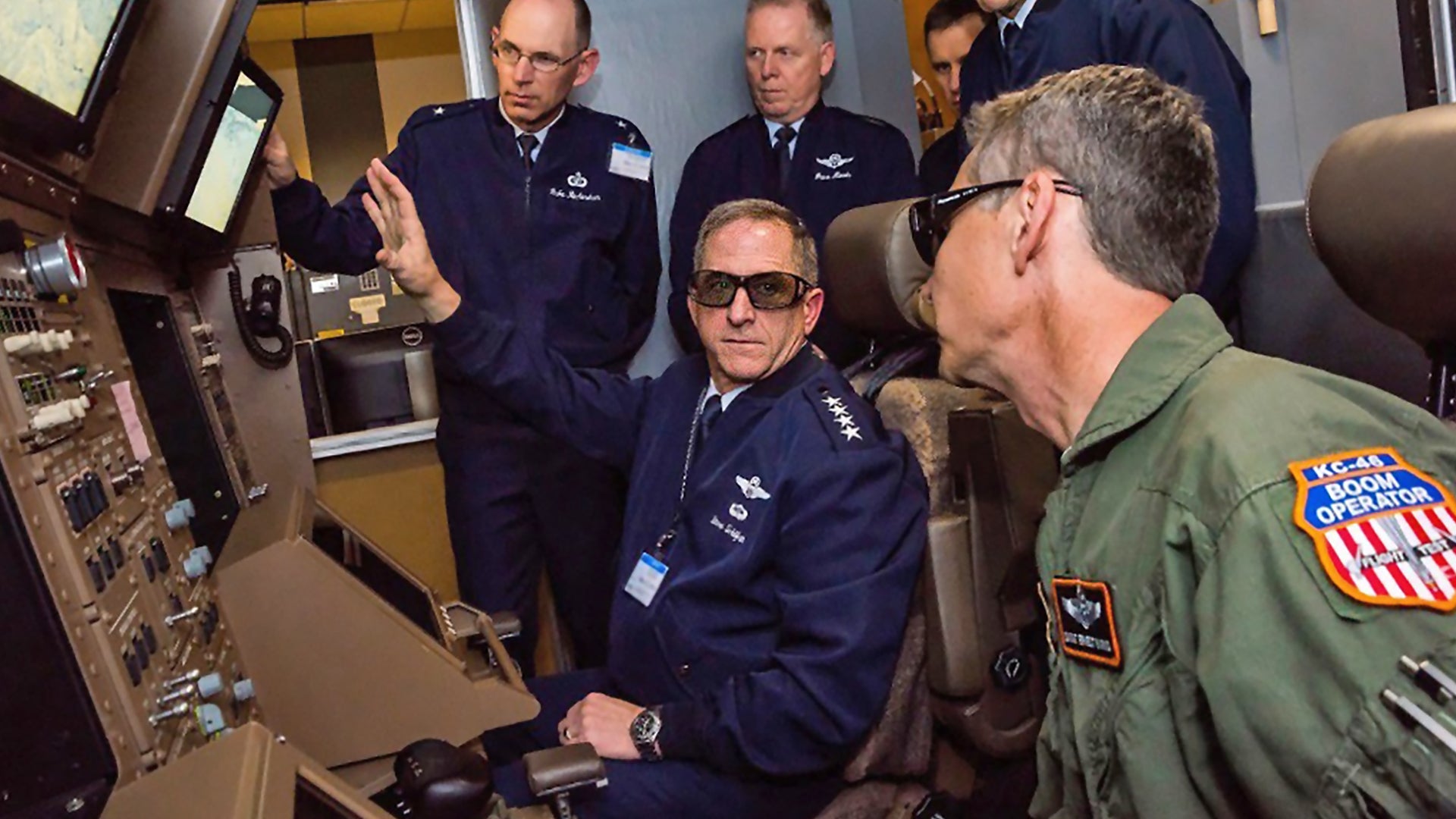I have long highlighted the glaring need for a low-observable (stealthy) tanker to support the thousands of relatively short-ranged stealth fighters the USAF will continue to purchase in through coming decades—aircraft that are expected to take on peer states with high-end anti-access capabilities, like China. You can read the entire case for such a platform in this past feature of mine. Many laughed off the idea when that piece was published, but it has since become a very real concept within the flying force. Now the USAF’s Chief Of Staff, General David Goldfein, has poured a bit of cold water on the idea, while at the same time positing a far more exotic if not outright puzzling one—a tanker that flies in low earth orbit.
What?
Aviation Week recently inquired about the status of the survivable tanker initiative, with Goldfein replying:
“The days of buying individual platforms that we then described as game changers—those days are behind us… There actually are no silver bullets on the horizon.”
As the USAF’s top uniformed officer, Goldfein’s primary vision for the flying force has included putting far heavier emphasis on networking together an ever more diverse constellation of weapons and sensor systems distributed over a wide area as opposed to packing a ton of capability into singular platforms. This distributed concept of operations relies very heavily on secure communications and especially beyond-line-of-site data-links whose abilities are largely made possible by space-based satellites. Some see this reality as the glaring Achilles heel of Goldfein’s vision. It’s hard to imagine why such a strategy totally eliminates the advantages that some so called ‘silver bullet’ capabilities could provide. The two ideas don’t seem mutually exclusive.
Goldfein continues:
“I actually don’t know if the next version of tanker operates in the air or operates at low earth orbit.. I don’t know if it’s manned or unmanned, and I actually don’t care that much as long as it brings the attributes we need to win… It might sound a little bit odd that the commander of Air Mobility Command is talking to Air Force Space Command about development of the next tanker, but it makes perfect sense to me.”
When it comes to refueling air breathing jet aircraft like fighters, airlifters, and bombers, no, this statement makes zero sense at all. In fact, it is outright preposterous.
Maybe what the General means is that a tanker may be needed to refuel satellites in orbit, some of which could be weaponized to the point of carrying kinetic munitions in the coming decades. It is not hard to imagine a space plane of sorts being designed to refuel and service objects in low earth orbit. In fact, the Pentagon is openly funding a system that could be capable of just that now and certainly others have been rumored to exist in the past.
With more fuel, satellites could be designed to maneuver more freely and aggressively, adding to their flexibility, unpredictability, and survivability. Pentagon satellites are facing growing anti-satellite threats from Russia and China and even rogue states. Being able to better protect them is becoming a very urgent defense priority.

Adding modular plug-and-play capabilities that can be updated while on orbit, or even rearming space-based weapons platforms as needed would also bring big advantages in a future where space is a highly active battlefield.
It’s clear that the USAF has plenty of non-disclosed capabilities and plans related to space. Maybe he sees a future where some jet attack and transport aircraft give way, at least partially, to suborbital or orbital systems. But this is a huge, expensive, long-term proposition. Meanwhile, we know the Pentagon is buying thousands of stealthy fighter jets in the coming decades and has plans for next generation systems as well. These aircraft will serve well into the second half of this century. So regardless of if the USAF wants to flood low earth orbit with weaponry, its very expensive fighter fleet will have to maintain relevancy for many, many decades to come, all the while America’s potential enemies continue to push out their anti-access capabilities farther from their own shores, creating massive swathes of contested airspace where traditional tankers will become increasingly vulnerable.
The introduction of a large fleet of unmanned combat air vehicles (UCAVs) would go a long way to making the USAF less dependent on large tanker aircraft and doing so clearly fills Goldfein’s distributed, network-based air combat vision—you can read all about UCAVs and why the USAF acts as if they don’t even exist in this past special feature of mine—but they have nothing to do with suborbital or orbital flight.
With all this in mind, it seems like an absurd leap to go from talking about a survivable tanker to support existing combat aircraft and those still to come, to some sort of an orbital tanker concept, which really isn’t new. One doesn’t displace the need for the other. He also inserted Air Mobility Command (AMC) into his remarks. AMC doesn’t deal with space logistics, at least not yet.

This isn’t the first time an Air Force leader has made eyebrow raising and/or outright embarrassing claims about the service’s vision for space. These statements are largely the result of the Air Force’s struggling with all its might to keep its grasp on space as the White House pushes for an independent Space Force. Virtually anywhere space could be injected into the USAF talking points it has been, sometimes with disastrous results. But it’s odd to hear this kind of thing from Goldfein, who is usually an eloquent and thoughtful speaker about his vision for the force and its fighting doctrine.
In the end, the Air Force would be well advised to ensure the hundreds of billions of dollars worth of fighters it is planning to buy for the coming decades have the support assets they need to be mission relevant before they start making down payments on a fleet of space tankers.
Contact the author: Tyler@thedrive.com
